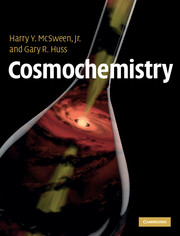Book contents
- Frontmatter
- Contents
- Preface
- 1 Introduction to cosmochemistry
- 2 Nuclides and elements: the building blocks of matter
- 3 Origin of the elements
- 4 Solar system and cosmic abundances: elements and isotopes
- 5 Presolar grains: a record of stellar nucleosynthesis and processes in interstellar space
- 6 Meteorites: a record of nebular and planetary processes
- 7 Cosmochemical and geochemical fractionations
- 8 Radioisotopes as chronometers
- 9 Chronology of the solar system from radioactive isotopes
- 10 The most volatile elements and compounds: organic matter, noble gases, and ices
- 11 Chemistry of anhydrous planetesimals
- 12 Chemistry of comets and other ice-bearing planetesimals
- 13 Geochemical exploration of planets: Moon and Mars as case studies
- 14 Cosmochemical models for the formation of the solar system
- Appendix: Some analytical techniques commonly used in cosmochemistry
- Index
- References
5 - Presolar grains: a record of stellar nucleosynthesis and processes in interstellar space
Published online by Cambridge University Press: 05 June 2012
- Frontmatter
- Contents
- Preface
- 1 Introduction to cosmochemistry
- 2 Nuclides and elements: the building blocks of matter
- 3 Origin of the elements
- 4 Solar system and cosmic abundances: elements and isotopes
- 5 Presolar grains: a record of stellar nucleosynthesis and processes in interstellar space
- 6 Meteorites: a record of nebular and planetary processes
- 7 Cosmochemical and geochemical fractionations
- 8 Radioisotopes as chronometers
- 9 Chronology of the solar system from radioactive isotopes
- 10 The most volatile elements and compounds: organic matter, noble gases, and ices
- 11 Chemistry of anhydrous planetesimals
- 12 Chemistry of comets and other ice-bearing planetesimals
- 13 Geochemical exploration of planets: Moon and Mars as case studies
- 14 Cosmochemical models for the formation of the solar system
- Appendix: Some analytical techniques commonly used in cosmochemistry
- Index
- References
Summary
Overview
Presolar grains give us a direct window into stellar nucleosynthesis and provide probes of processes in interstellar space and in the solar nebula. Known types of presolar grains originated in the winds or ejecta of stars that lived and died before the solar system formed. After presenting a short history of how presolar grains came to be recognized, we describe how to identify presolar grains, the techniques used to study them, and the various types of grains currently available for study. We then review what presolar grains can tell us about stellar nucleosynthesis, the environments around evolved stars and in the interstellar medium, and how they can be used as probes of conditions in the early solar system.
Grains that predate the solar system
In recent years, a new source of information about stellar nucleosynthesis and the history of the elements between their ejection from stars and their incorporation into the solar system has become available. This source is the tiny dust grains that condensed from gas ejected from stars at the end of their lives and that survived unaltered to be incorporated into solar system materials. These presolar grains (Fig. 5.1) originated before the solar system formed and were part of the raw materials for the Sun, the planets, and other solar-system objects. They survived the collapse of the Sun's parent molecular cloud and the formation of the accretion disk and were incorporated essentially unchanged into the parent bodies of the chondritic meteorites.
- Type
- Chapter
- Information
- Cosmochemistry , pp. 120 - 156Publisher: Cambridge University PressPrint publication year: 2010
References
- 1
- Cited by



